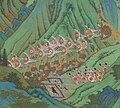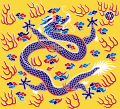National
Present
Historical flags
| Flag | Date | Use | Description |
|---|---|---|---|
 | 3 Oct. 1893 - 8 Apr. 1945 24 Apr. 1946 - 22 Oct. 1953 | Protectorate flag of Kingdom of Laos | Ratio is 2:3. Influences: |
 | 12 Oct. 1945 - 24 Apr. 1946 | State flag and civil ensign of Kingdom of Laos [4] [5] | Three horizontal stripes, with the middle stripe in blue being twice the height of the top and bottom red stripes. In the middle is a white disc, the diameter of the disc is 4⁄5 the height of the blue stripe. Ratio is 2:3. Influences: |
 | 22 Oct. 1953 - 2 Dec. 1975 | State flag and civil ensign of Kingdom of Laos | Ratio is 2:3. Influences: |






































































